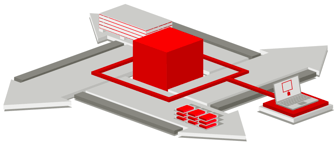When it comes to packaging, the word “lean” is often used to describe objectives. Many companies want lean packaging processes that reduce waste and boost margins. Others want lean distribution procedures that help them meet tight customer deadlines. And still others may literally want lean packaging that uses few materials and meets sustainability goals.
In manufacturing, “lean” isn’t a new concept. Whether he ever used the word or not, Henry Ford was looking for a leaner process when he revolutionized manufacturing in the early 20th century. After World War II, Toyota took “lean” to a whole new level with the Toyota Production System. The TPS idea became a template for manufacturers around the world.
Kaizen is a process that helps a manufacturer make incremental improvement on a daily basis.
In recent years, TPS has grown and evolved into a comprehensive manufacturing mindset and culture. It’s called “kaizen,” which is the Japanese word for “change for better.” In the manufacturing world, kaizen means “continuous improvement.”
When implemented properly, kaizen is a process that helps a manufacturer make incremental improvement on a daily basis. Those small daily improvements compound over time and accumulate into substantial reductions in waste and increases in efficiency.
 At Deufol, we long ago embraced kaizen and implemented it as a guiding philosophy from our executive offices all the way to our warehouses, manufacturing centers, and other facilities. We’ve seen firsthand how kaizen not only benefits our internal processes, but also helps our customers with their packaging and distribution efforts.
At Deufol, we long ago embraced kaizen and implemented it as a guiding philosophy from our executive offices all the way to our warehouses, manufacturing centers, and other facilities. We’ve seen firsthand how kaizen not only benefits our internal processes, but also helps our customers with their packaging and distribution efforts.
Kaizen can be especially helpful with thermoforming packaging. Manufacturers of consumer goods are under increasing pressure from large retailers to meet lower price points, tighter deadlines, and higher quality standards. A kaizen approach can help a manufacturer incrementally make the improvements needed to keep up with retailer demand.
Not sure how Kaizen would impact your packaging? Below are three of the most important facets of Kaizen philosophy, along with examples of how they work in a practical sense in the packaging process. If you’ve struggled to meet the demands of your top retailer customers, kaizen could be the solution you’re looking for.
1. Innovation at All Levels
One of the tenets of kaizen is that all employees are actively engaged in improving the company and the process. It’s not just executives and managers handing down orders. Innovation and improvement can come from a worker on a production line just as easily as it could come from a high-level engineer.
 This is facilitated through regular daily team meetings. Often, they happen on the floor as the production team gathers to have a quick review of goals, challenges, and areas for improvement.
This is facilitated through regular daily team meetings. Often, they happen on the floor as the production team gathers to have a quick review of goals, challenges, and areas for improvement.
During this time, anyone can recommend an improvement. For instance, a team member may notice that if two production steps are reversed in order in the process, more units may flow through production at a higher speed.
That kind of insight can often only come from those who are on the front lines. Kaizen encourages and embraces insight at all levels and then accommodates fast implementation of recommendations. It’s hard to get that kind of fast improvement with a traditional top-down approach.
2. Continuous Improvement
Continuous improvement is at the very core of kaizen. Again, this is accomplished through the regular team gatherings, which may happen daily or even multiple times a day. Every member of the team is aware of the current state and the improvements that will be implemented to drive better results.
At the end of the day or the designated time period, the team reconvenes to review the improvements, discuss how they were implemented, and decide on next steps. If improvement wasn’t achieved, the team may go back to the drawing board. If there was improvement, the team may set even higher benchmarks for the next day.
The compounding of small improvements
leads to big results.
Again, the incremental improvements on a daily basis may be small. However, if those improvements are continuously increased and pushed every day, they start to add up to big gains. Production time goes down. Costs go down. Quality goes up. The compounding of small improvements leads to big results.
3. Root Cause Analysis of Issues
It’s an unfortunate reality that sometimes issues happen in the manufacturing business. A product is somehow made with a defect. A shipment shows up after the retailer’s deadline. A package doesn’t meet a retailer’s shelf space standards.
 While these things do happen in the thermoforming industry, the goal should be to minimize or completely eliminate them. In kaizen, root cause analysis is a core principle for issue resolution. Resolution doesn’t just involve solving the problem. It also involves asking why the issue happened in the first place.
While these things do happen in the thermoforming industry, the goal should be to minimize or completely eliminate them. In kaizen, root cause analysis is a core principle for issue resolution. Resolution doesn’t just involve solving the problem. It also involves asking why the issue happened in the first place.
Why did the packaging come off the production line slower than anticipated? Why did a distribution bottleneck happen at the regional warehouse? Why did a product mishap occur while the container was in-transit?
By asking “why,” you can then not only solve the current issue, but prevent the issue from repeating itself in the future. Kaizen creates an “ask why” culture at all levels of the process.
Implementing kaizen is often a long process. You have to educate your team and rethink your processes. If you want fast results, it may be more useful to partner with a packaging company that already has a kaizen philosophy. As you explore thermoforming packaging partners, look beyond price and examine their process. To get sustainable, long-term results, you may want a partner who believes in the power of kaizen. ![]()






Let Us Know What You Thought about this Post.
Put your Comment Below.